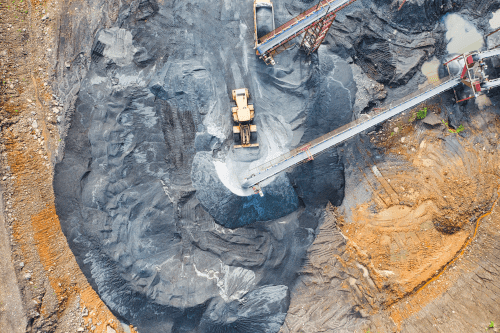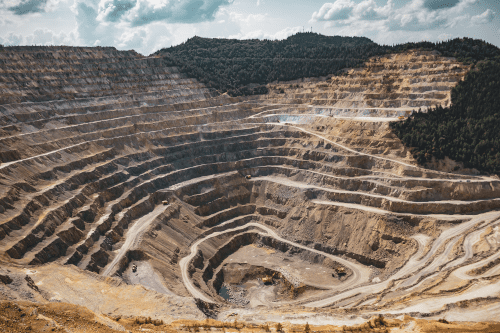RARE-EARTH ELEMENTS:
A NATIONAL SECURITY CRISIS
BECOME A MEMBER TODAY
TAX-DEDUCTIBLE DONATION
ATTEND OUR SEMINARS
weekly news
“The Middle East has the oil, but China has the rare earths,” spoken by Deng Xiaoping, Supreme Leader of China, in 1992. What did he mean and what did he know that we didn’t?
The “rare earths” that Deng was referring to are known as “Rare-Earth Elements” (REEs). They are composed of 17 complex elements that are unpronounceable, but are essential in four industries: high tech, pharmaceuticals, national defense, and energy. The list of products in which they are used is almost endless: computers, iPhones, TV screens, guided missiles, fighter jets, sonar systems, electric grid, solar panels, 5G technology, and on and on.
OK, so what’s the problem?
The problem is we are almost completely dependent on China for these precious REEs!
“Black Swan” events like COVID-19 underscore the supply chain disruptions that can occur when products such as rare earths are concentrated in one country, like China”, says Mike Rosenstreich, Hexagon Energy Materials managing director. There are emerging revelations about COVID-19 and China’s involvement. It appears they caused it, spread it, covered it up, and are profiting from it. In addition to the growing outrage, the world is suddenly focused on supply chains and “made in China.”
The same country that has no concern for child labor laws or toxic waste; that considers intellectual property theft a national strategy; that weaponized REEs against Japan in 2010, and threatened us during the trade negotiations in 2019, has now left no doubt that REEs are the 21st century oil and China is the 21st century OPEC! They threaten, not only our national security, but our way of life as well.
It gets worse.
Because they control almost 100% of the market, they can leverage, thru overproduction and price manipulation, to bankrupt their competition. In fact, in 2015, China relaxed REE export rules and flooded the market. Prices fell, forcing Molycorp – owner of the only functioning REE mine in the U.S.(at Mountain Pass in California) – to file Chapter 11 bankruptcy.
We find ourselves in this position thru a combination of ignorance, apathy, incompetence, and being our own worst enemy. Until the 1990s, we were the leading exporter of REEs. Then, while we were undermining exploration and mining of REEs, China was expanding their supplies and tightening their control over production and exports. By 2008, they controlled over 90% of world production; by 2011, 97%.
As China was boosting its R&D of REEs, we were engaging in policies that can only be described as openly hostile to the mining industry. The Bureau of Mines was closed. Increased regulations caused the granting of multiple permits to take from 7-10 years. 100s of thousands of acres of federal land was withdrawn from exploration. Concern over toxic waste created neverending litigation. According to the United Stated Geological Survey (USGS), we have enough REEs to last 100s of years. We are suffering from policy, not geology.
America was in control of global production of REEs thru the ‘60s; but, except for color TVs, were of little commercial value. That was to change in the ‘80s when GM secured a multimillion-dollar contract from the Pentagon. They discovered a new category of magnets many times more powerful than existing ones. Suddenly, stereos, earphones, and TVs lasted longer. Computers became smaller and faster. Cars became faster and safer. Missiles became more accurate. Fossil fuels became easier to extract and refine. MRIs became clearer. By 1994, permanent magnets were made in America, by Americans, sold in America and throughout the world.
It is here that China enters the picture. Aided by cheap labor, government cooperation, and no environmental concerns, China surpassed the U.S. in the mining and exporting of REEs. However, they had one problem. They lacked the technical expertise to refine the REEs into permanent magnets.
Never let it be said that we don’t come to the aid of our adversaries in their time of need. This is where the story gets ugly.
General Motors sold its rare-earth magnet technology to Magnequench, a Chinese/American consortium which repeatedly lied to our government to get export licenses to transfer their production line to the PRC, and then shut down U.S. operations. Having outsourced military and commercial control should have triggered major concerns. President Clinton had the authority to block the sale if there was “credible evidence…that the foreign exercising of control might take action that threatens to impair national security” (1988 Federal law). Neither Clinton nor the Committee on Foreign Investment in the U.S. (CFIUS) found such “credible evidence.” So, with administration and CFIUS approval, the sale took place.
It gets still worse.
Clinton closed the US Bureau of Mines. They had been the leading player in the R&D of energy resources, including REEs. Most domestic production was shut down and relocated to…China!
In 1998, Clinton closed the last independent mine in the U.S. at Mountain Pass. The reason? It threatened the existence of the desert tortoise (not kidding). Clinton wasn’t done. On October 10, 2000, he signed the China Trade Bill into law. It gave China unfettered access to American technology that produced REE magnets. The next two administrations did nothing to reverse these errors. There were two meager attempts to re-open Mountain Pass. Neither was successful. Faced with the same government restrictions, permit delays, environmental concerns, and endless lawsuits, it filed bankruptcy in 2015.
Oh, there’s more.
The bankruptcy court sold the assets to another Chinese consortium. Indeed, “we have met the enemy and he is us.”
James Lifton, founder of the REE consulting firm Technology Metals Research, believes the US will never regain dominance. “China has invested billions in rare earths…they’ve educated thousands of mineral engineers and filed hundreds of patents…and now, suddenly, we want to bring it back to the U.S.? “No way!”
We Need Your Help!
You can help Citizens For National Security inform Members of Congress, the American people, and help us produce a documentary that exposes China’s theft of our most critical materials and production facilities for our high-tech defense weapon system. Please make a taxable-deductible donation Today.
And now, as Paul Harvey used to say “Here’s the rest of the story.” Change is on the march. China’s national policy of conspiracies, cover-ups, and IP theft has finally backfired. All of a sudden, focus has turned to supply chains. Americans are asking “Why do we depend on China for everything from clothing, to industrial chemicals, to pharmaceuticals, to, even REEs?” Our founding fathers understood the problem of import overreliance – that domestic production of essential goods was crucial to the success and independence of the new nation. Treasury Secretary Alexander Hamilton put it this way: “The wealth…independence and security of a country appear to be connected with the prosperity of manufacturers. Every nation…ought to endeavor to possess within itself all the essentials of national supply.” Our current government would do well to heed this advice. It is timeless.
Hoping is not a plan. Without action, we could easily see ourselves with shortages of “essentials of national security.” Without much attention, on July 24, 2017, a Presidential Declaration was issued directing the federal government to develop a plan to reduce America’s dependence on REEs from China. Since then, a host of executive orders and House legislation have been issued: S1052 authorizes the Office of Fossil Energy to develop separation technologies for the extraction and recovery of REEs; S2093 allows for investment exempt from anti-trust laws. Others include EO13817, SO3359, HR2689, Reclamation Act HR2262, Hardrock Mining and Reclamation Act S1386.
Those, and more, for the first time define REEs as “critical minerals” and further, “increase their exploration, mining, concentration, separation, alloying, recycling, and reprocessing; and streamline permitting for creating mines for the benefit of the American people and in an environmentally acceptable manner.” Senators Cotton, Blackburn and Menendez are currently introducing legislation called “Securing America’s Medicine Cabinet” (SAM-C Act). It is a bipartisan effort to address our supply chain vulnerability by encouraging drug manufacturers to bring “active pharmaceutical ingredients” (APIs) creation back to this country. Although dealing with pharmaceuticals, it could serve as a template for REE legislation.
The Administration seems to have awakened. “The department continues to work closely with the president, Congress, and the industrial base to mitigate reliance on China for rare-earth minerals,” says Lt. Col. Mike Andrews, Defense Department spokesman. According to the Pentagon’s Ellen Lord, “We will be coming out with a whole series of actions…to make sure we work with our allies…so that we don’t have the dependency on China.” Tim Perry, from the Interior Department, noted “Any shortages of these resources [REEs] constitutes a strategic vulnerability.”
On July 22, 2019, President Trump invoked a section of the Defense Production Act (DPA) authorizing funds to American corporations for the domestic mining of REEs. The National Defense Authorization Act, passed in 2019, seeks to wean the government and defense contractors away from seeking their supplies of REEs from hostile countries. Mountain Pass mine has re-opened, but is doing no refining and is partially owned by Shenghe Resources, a Chinese holding company.
There is also growing interest in R&D for new REE technologies. Production from coal, sea water, and off shore mining is among them. Hexagon Energy Materials is developing a process it calls Rapid SX. It turbocharges metal extraction and separating REEs. Mike Rosenstreich, says “…it can take months for metals to start off at one end of a conventional plant and end up as product on the other side…we think that becomes a matter of hours, perhaps a day or so, with Rapid SX.”
Obviously, the goal of any new technology is to make a cheaper, more efficient, and cleaner product. It has also been suggested that a retired Naval ship, carrier or cruiser, for example, be remodeled to perform REE refining. It could be done in international waters. Admittedly, its cost and feasibility remain an open question.
Of particular interest is USA Rare Earth which has opened a pilot plant in Colorado that uses a process allowing them to fully separate and purify REEs. This would enable them to compete with China on pricing.
All noble ventures. All remain works in progress. Still, the path has been set. There is clearly growing interest and action in government and private sectors. American ambition, know-how, and creativity have been triggered. These are necessary to give producers the edge they need to disrupt China’s dominance over the REE supply chain.
Companies with some interest in re-entering the market include: Australia-based Lynas Corp, Texas Mineral Resources, Alaska’s UCore Minerals, Materion, Canada’s Medallion Resources Ltd, Search Minerals Inc, Nebraska’s NioCorp Developments Ltd, and Texas’ Blue Line Corp. These, and other companies will need federal funds for their REE projects. However, there will be no serious interest from the private sector as long as the following problems exist: government closures of land dedicated to mining, a prolonged permit process, toxic waste produced at the refining stage, EPA interference, and endless legal challenges. And, of course, I must include the contributions of our own arrogance, apathy, ignorance, and naivete. And yet, we also have a memory. We remember the oil embargo of ’73. If it takes the pain of that memory to commit to “never again,” then so be it.
The first function of government is to protect its citizens. This time we need government to put country before party or politics. The reality is, creating a viable, effective REE mining business from scratch could take years. Ryan Castilloux, of rare earth research firm Adamas Intelligence, called the governments’ actions to date “toes in the water.” There must be more bipartisan, definitive action…NOW!
What’s it going to take? China’s military marching into Hong Kong or, perhaps, completing military bases on the South China Sea islands thus controlling the sea lanes? What recourse do we have? Warn against, threaten sanctions, and, of course, the old standby UN resolution? And when China threatens to restrict or cut off our REEs…then what? Instead of having another December 7th or September 11th awakening, we need to be pro-active…this time. There has been enough testimony before Congress, enough Executive Orders, enough proposed legislation. ACT!
Regardless of the history, the mistakes, new government interest, etc., there remain two complex, currently impenetrable obstacles to establishing a successful domestic REE mining industry: the permit process and toxic waste produced at the refining stage of production.
At this time, the U.S. has no uniform permit process or guidance for miners. They must satisfy federal and state-specific requirements. They must also contend with a myriad of local standards which vary depending on the location of the mine. Sometimes, these requirements and standards overlap or even conflict with each other. While their permit applications are being held at bay in a bureaucratic maze, miners must also keep abreast of changes in rules and legal standards stemming from endless litigation. The potential number of federal, state, and local laws can require 70, or more, permits. The process can take from 7-10 years.
Here are some definitive steps in the right direction to overcome this roadblock: (1) Congressional action – legislation to create a national “Rare Earth Coordination Board.” Its purpose would be to eliminate duplicate and conflicting laws – to streamline the process. One agency. One set of rules. (2) Form statelevel review panels to reduce confusion. (3) Invoke the supremacy clause of the Constitution which states that federal law preempts state and local laws. In that case, miners would only have to deal with the Department of the Interior to drill on federal land.
The second major obstacle, toxic waste, is even more frustrating. The byproduct of REE extraction produces dangerous gases and radioactive wastewater. Obviously, no legislative fix is relevant. There is no effective, practical filtration, purification system currently available. Huge investment in such systems are required. Currently, there are experimental models being investigated; but, at best, are years away from conclusions. Until research on them is completed, we must find alternate, viable substitutes for REEs, and stockpile them for emergencies.
We challenge Secretary of Energy Dan Brouillette, DNI Ratcliff, Joint Chiefs Chairman Milly, Chief of Staff Meadows, and Secretary of Defense Esper to end the procrastination. Petition, influence, coerce, convince the President. Re-open federal lands for exploration, create public/private partnerships with tax incentives, encourage alternate sources, fund research for new technologies, ease the permit process, insulate against frivolous litigation, protect the market against Chinese manipulation by agreeing to purchase REEs from American producers.
One caveat. Keep in mind, as we raise our collective fists and repeat with patriotic fervor, “never again,” there is a cost…literally. With domestic production, prices go up. But remember, when you pay “too much” for your next computer, iPhone, TV, or car, it probably wasn’t “made in China.”
We have succeeded in becoming energy independent. In fact, we are the world leader in oil and natural gas production. We can do the same with REEs. But first, a re-think is necessary. REEs are the 21st century oil and we have an embarrassment of riches. The executive orders and pending legislation are a good start. It is clear the Trump administration is committed to an improved mineral policy. However, commitment is not enough. ACTION!
Pini Althaus, CEO of USA Rare Earth, claims that the mine in Colorado alone would have “…a significant impact on the economy. We’re talking about a $500 billion to $1 trillion impact, in terms of job creation and manufacturing…”
If REE independence and supply chain disruption still aren’t enough motivation, perhaps the bonus of increased mining-related GDP, tax revenue, and jobs created will make it irresistible to the businessman perspective of our President.
Previously described efforts have, thus far, been directed to rejuvenate a domestic REE industry that evaporated three decades ago. If lawmakers, the Pentagon, and the White House are now taking this seriously, why has there been such little progress and such reluctance from the private sector? Because no one invests in promises and “taking it seriously.”
Many REE experts point out that that the government interest thus far provides market solutions for what is actually a non-market problem. We alluded to it earlier. The Chinese REE mining industry is stateowned. Therefore, it controls production and pricing. Normal economic rules don’t apply. The entire market can be rendered uneconomical if Beijing blinks. Uncertain demand. Uncertain price. Uncertain technology.
It’s time to put the U.S. REE mining industry on a level playing field with China. Everyone agrees that this is a national security issue. Therefore, in the name of national security, create a federal government entity to underwrite the entire process. Nationalize the industry. There is precedent – the shipyards during World War II. The complete solution has many tentacles: legislative efforts, federal cooperation to relax permit delays, R&D in new technology to reduce toxic waste, and state capitalism. We hope the Administration is up to the challenge.
We Need Your Help!
You can help Citizens For National Security inform Members of Congress, the American people, and help us produce a documentary that exposes China’s theft of our most critical materials and production facilities for our high-tech defense weapon system. Please make a taxable-deductible donation Today.


